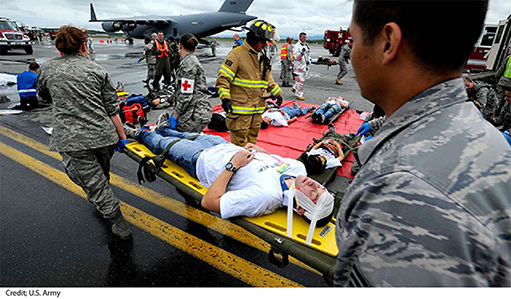The SIGZEEN Checkered Color-Coded Identification and Visual Communication System Innovated and Developed for First Responders and Other Emergency Responders - Now Integrated into Frontline Healthcare Workers Preparedness and Response Planning for COVID-19 Pandemic and Beyond
___________________________________________________________________________

SIGZEEN CBRNE TRIANGLE Project (2008 - 2025)
The COVID 19 pandemic took the entire world health care system and global emergency preparedness and response capabilities by surprise. Over the course of 2020 we are all learning about the coronavirus, how it affects the entire global population, health care systems, including what measures we should take to overcome ongoing and evolving challenges related to emerging variants and beyond.
In fact, the pandemic crisis is not new to the world governments, international intelligence agencies, emergency responders, medical and health care communities. The September 11, 2001 terrorist attack and the anthrax incident of 2001 compelled governments around the world to pay immediate attention to threats of weapons of mass destruction and the possibility of the spread of deadly viruses.
Governments and international agencies such as NATO (North Atlantic Treaty Organization) and the WHO (World Health Organization) were well aware of the possibility of a pandemic triggered by terrorist acts, extremists, criminal activists, foreign adversaries, natural or human-made disease outbreaks and intentional or accidental leaks of deadly viruses from laboratories.
The head of the emergency program at the World Health Organization (WHO) Mike Ryan, MD., warned during the end-of-year (2020) media briefing that, "even though the coronavirus pandemic has been very severe, this is not necessarily the big one. The coronavirus is only a wake-up call, and all nations must prepare for another global health crisis". The World Health Organization (WHO) statement "The Best time to prevent the next pandemic is now: countries join voices for better emergency preparedness".
Checkered Color-Coded Identification and Communication System
Identify Frist Responders

Identify Frontline Hospital Workers
The Color-Coded identification system for health care workers consists of armbands, wristbands, and ID patches that specify a different color assigned to a specific health care worker based on their profession.
. more ....
Who We Are
Since 2008 (Project Milestone 2008-2021) we have been involved in researching, innovating and developing concepts, equipment, programs and systems that relate to enhancing the health and safety of first responders (law enforcement, fire and rescue, medics and paramedics), other emergency responders (military, sheriff, border service, CBRN personnel) and frontline health care workers (hospital and field health care workers).
We are the first to innovate and develop a distinguishing identification and visual communication system in the form of checkered high visibility apparel for integrated emergency responders and frontline healthcare workers. The key objective of the project is to build a joint emergency response force: first responders and other emergency responders "External Emergency Response Forces" with frontline healthcare workers "Internal Emergency Response Forces".
We also focus on the risks posed by various chemical and biological agents, cyber, EMP, and direct attacks on power grids and telecommunications infrastructure that could combine with CBRNE and biological pandemic events. Such a combination of events could significantly impact the communication capabilities of first responders, other emergency responders and healthcare workers.
Our Speaker Presentation at NATO CBRN Workshop 2014
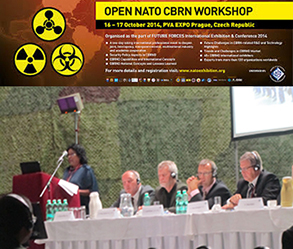
In 2014, we addressed the nature of cyber attacks, EMP, and direct threats at the NATO CBRN Defence Conference held in Prague, Czech Republic. The topic was cyber, EMP and physical attacks on power grids and telecommunications infrastructure and the color-coded identification and visual communication system for first responders and other emergency responders
NATO CBRN Training and First Responders
In 2014, we addressed the nature of cyber attacks, EMP, and direct threats at the NATO CBRN Defence Conference held in Prague, Czech Republic. The topic was cyber, EMP and physical attacks on power grids and telecommunications infrastructure and the color-coded identification and visual communication system for first responders and other emergency responders
In 2014, NATO conducted a CBRN training course for first responders, firefighters and paramedics to have a level of preparedness when responding to CBRN incidents. Preparing first responders for CBRN incidents NATO’s role in cyberspace https://www.nato.int/docu/review/articles/2019/02/12/natos-role-in-cyberspace/index.html, The US assessment of electromagnetic pulse (EMP) attacks: "Nuclear EMP attack scenarios and combined arms cyber warfare".
Our Objectives
Our objective is to facilitate an effective and cohesive workforce and a safe work environment for all emergency responders, first responders, other emergency responders and frontline healthcare workers. This would include the ability to ensure that they are safe and protected and that they can efficiently communicate and work together to protect themselves and the public and to save lives in the event of a CBRNE (Chemical, Biological, Radiological, Nuclear, Explosive) or deadly pandemic crisis.
The project comprises two phases. The first phase of the project (2008-2020) focused on developing a distinctive identification and communication system for first responders and other emergency responders, which turned out to be a resounding success. The second phase (2018 - 2025) is focused on developing a distinguishing identification system to protect health workers by building an effective and safe work environment in the hospital facilities and minimizing the control of the spreading of diseases in the hospital environment.
The main focus of the project is to integrate emergency response forces, first responders and other emergency responders (External Emergency Response Forces) and frontline healthcare workers (Internal Emergency Response Forces) by developing a comprehensive and integrated communications system by 2025.
SIGZEEN CBRNE TRIANGLE Project

The CBRNE Triangle Project is designed to distinguish first responders (law enforcement, fire and rescue, medical and paramedics) other emergency responders (military, sheriff, border service, CBRN personnel) and frontline workers (hospital and field healthcare workers) from other workers and the general public. It is also a system that facilitates communication among emergency responders during chaotic and crisis situations and when their standard communication system fails.
The CBRNE Triangle project is in a 17-year development program (2008-2025). Our mission began 13 years ago in 2008 by gathering information to address the chemical and biological infectious disease threats during the 2010 Vancouver Winter Olympics "Olympic Security Assessing the Risk of Terrorism".
As a result of comprehensive research and detailed assessments on CBRN threats and complex challenges, we innovated and developed the CBRNE Triangle Project. This project consists of the Color-Coded Identification and Visual Communication System (Color-Coded IVC System) in the form of Checkered High Visibility Apparel. This identification system uses various color-coded straps and bands allocated to specific emergency groups and personnel for the purpose of distinguishing other workers and the general public. We first introduced this identification system to law enforcement during the 2010 Vancouver Winter Olympics and it was well-received.
Current Users: Today, all police services in British Columbia, Canada are using this Checkered HiVis identification system to distinguish their members from other workers and the public. Other emergency services that use this system are: some RCMP (Royal Canadian Mounted Police) officers, BC Sheriff Service, Fire and Rescue, Medical Services, Ministry of Transportation, Canada Border Service Agency, and more ....
Genesis of the Project

We assessed various scenarios including research carried out by national and international governments, military, international agencies such as NATO, World Health Organization (WHO) and the private sector about CBRNE events and biological terrorism.
The U.S. Rand Corp Studies about Integrating Health Workers with Other Emergency Responders
The U.S. Rand Corp report 2003 "Emergency Responders' view on their Protection Needs. "
The U.S. Rand Corp report 2002 "How Well-Integrated Are Local Public Health Departments and Hospitals With the Preparedness Activities of Other Emergency Responders?
"However, despite these important strides, another key challenge remains: Are local public health agencies and our nation's hospitals (both public and private) prepared to deal with biological or chemical terrorism?"
"In addition, a key concern has been whether the public health and medical communities are well integrated with the preparedness activities of other local emergency responders to address bioterrorism or other acts of terrorism inside our borders,
We assessed various scenarios including research carried out by national and international governments, military, international agencies such as NATO, World Health Organization (WHO) and the private sector about CBRNE events and biological terrorism.
The U.S. Dark Winter exercise in 2001: the United States high-level bio-terrorist attack simulation of the “Operation Dark Winter” tabletop Bioterrorism exercise" held at Andrews Air Force Base highlighted the impact of pandemics and the challenges health care systems and hospital facilities would encounter. "Operation Dark Winter" also revealed gaps in the health care, hospitals and emergency response systems including areas to be addressed and ways of bridging the system to enhance responses to global CBRNE and pandemic crises. The "Operation Dark Winter" exercise warned that a biological pandemic attack was imminent and how all governments, relevant agencies, emergency services and emergency responders should prepare with effective response plans.
Further, we evaluated the U.S. National Strategy for Chemical, Biological, Radiological, Nuclear, and Explosive (CBRNE) Standards and Canada CBRNE Strategy and NATO Preparing first responders for CBRN incidents.
The CBRNE Triangle project is a part of our comprehensive CBRN (Chemical, Biological, Radiological, and Nuclear) deterrence ( NATO CBRN Deterrence ) program which focuses on developing a concept for next-generation future airpower and information superiority - (www.eqquera.com). The gathering of information for this project will provide us with a complete understanding of the crisis of CBRN and pandemic events and how we should prepare and respond to such events.
Governments, Agencies and Stakeholders Actions and Feedback

WorkSafeBC 2020 Amendments to Part 8 the High-Visibility Apparel
The 2019 public hearing and stakeholders' feedback in June 2021, in June 2021, WorkSafeBC amendmend to the Occupational Health and Safety Regulation the protective clothing and equipment. Changes are: the public must be able to readily identify particular workers (police constables as defined in the police act, fire and rescue, BC emergency medical assistants or in any other capacity, a person who is employed in the Commercial Vehicle Safety and Enforcement branch of the Ministry of Transportation and Infrastructure (Stakeholders and Public feedback). more .....
Bridging the Gap - Interoperability Among First Responders and Frontline Healthcare Workers

SIGZEEN CBRNE Triangle Project (Second Phase) - Color-Coded Identification System for Hospital Frontline Workers
Today COVID - 19 has created unprecedented global health emergencies and complex challenges for frontline health care workers, hospital facilities and the healthcare system as a whole. Right now we are in a race against time to prepare for the increased threats of life-threatening variants of the Delta and future variants.
Experts recognize that these variants could place hospitals in much worse crises than the original COVID 19 virus. Studies also indicate that the Delta variant is more infectious and transmits much faster than COVID 19. The American Society for Microbiology "How Dangerous is the Delta Varian"During a pandemic crisis, doctors, nurses and other hospital workers are actively involved in providing the best quality care for patients and saving lives in an effort to control and stop the spread of the virus throughout the hospital environment. Therefore, it is important that they are provided with effective and healthy work environments.
Identify Frontline Workers as Who's Who
The first phase of the project (2008-2020) that focused on developing a distinguishing identification and communication system for first responders and other emergency responders was completed and well-received from first responders, stakeholders and the general public.
The second phase (2018 - 2025) of a distinguishing identification system for the health workers and facilitating an effective, safe and healthy work environment in hospital facilities is expected to be launched by the end of 2021. The main objective of this identification system is to provide a color-coded identification system for every frontline worker. Such an identification system will be able to tell who's who in hospital facilities, their duties and responsibilities, especially while wearing protective gear over their clothing.
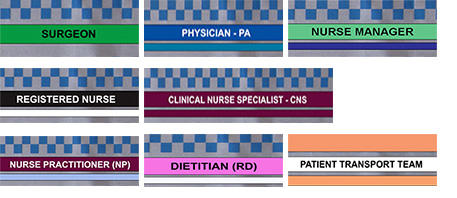

Joint Emergency Response Approach
Defense and medical experts recognize that a joint emergency response approach is the key to building a strong foundation for an effective and interoperable workforce for preparedness and response to CBRNE and pandemics. At the same time they also realize that the key area of joint forces capabilities is still underprepared and inadequately equipped in order to efficiently respond to CBRNE or pandemic crises.
The desired outcomes of our project are to close the above gap, integrate emergency response forces, first responders and other emergency responders (External Emergency Response Forces) and frontline healthcare workers (Internal Emergency Response Forces) in order to build effective preparedness and response plans.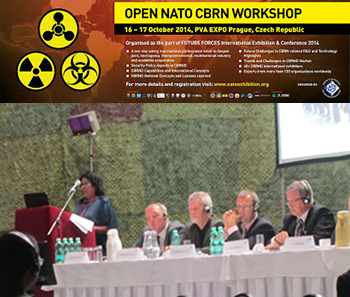
Speaker Presentation
Topic: Cyber, EMP and Physical attacks on power grids and telecommunications infrastructure, and safety of first responders”.
NATO CBRN Defence Conference Prague, Czech Republic - October 2014
Global Recognition and Our Presentation-
The threat of CBRN events is a global challenge. NATO's efforts to defend against CBRN threats have long been emphasized in various documents, including NATO Strategy policy for defending against CBRN threats and propose operations and response planning. NATO GUIDELINES FOR FIRST RESPONDERS TO A CBRN INCIDENT
______________________________________
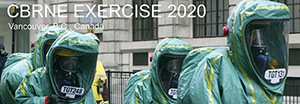
CBRNE EXERCISE 2020
The final phase of our project is to carry out the CBRNE EXCERCISE event in Vancouver British Columbia, Canada, in August 2020. This event intended to provide an overview of the Color-Coded Identification and Visual Communication System, and types of situations related to CBRNE attacks, including how emergency responders would communicate in the event of an attack on power grids and telecommunications infrastructure.
The CBRNE EXERCISE 2020 event has been postponed to 2022 due to COVID-19
__________________________________________
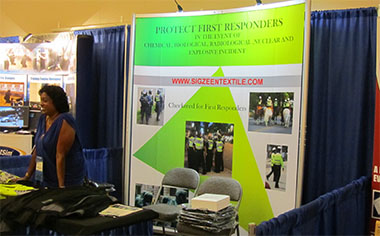
Chiefs of Police Conference 2014
Read more
